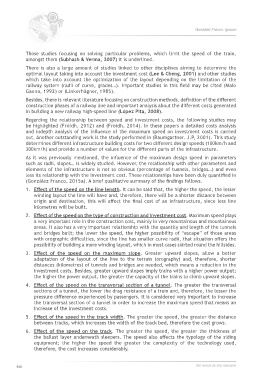Page 542 - 360.revista de Alta Velocidad - Nº 6
P. 542
González Franco, Ignacio
Those studies focusing on solving particular problems, which limit the speed of the train,
amongst them (Subhash & Verma, 2007) it is underlined.
There is also a large amount of studies linked to other disciplines aiming to determine the
optimal layout taking into account the investment cost (Lee & Cheng, 2001) and other studies
which take into account the optimization of the layout depending on the limitation of the
railway system (radii of curve, grades…). Important studies in this field may be cited (Malo
Gaona, 1992) or (Linkerhägner, 1985).
Besides, there is relevant literature focusing on construction methods, definition of the different
construction phases of a railway line and important analysis about the different costs generated
in building a new railway high-speed line (López Pita, 2008).
Regarding the relationship between speed and investment costs, the following studies may
be highlighted (Fröidh, 2012) and (Fröidh, 2014). In these papers a detailed costs analysis
and indepth analysis of the influence of the maximum speed on investment costs is carried
out. Another outstanding work is the study performed in (Baumgartner. J.P, 2001). This study
determines different infrastructure building costs for two different design speeds (100km/h and
300km/h) and provide a number of values for the different parts of the infrastructure.
As it was previously mentioned, the influence of the maximum design speed in parameters
such as radii, slopes… is widely studied. However, the relationship with other parameters and
elements of the infrastructure is not so obvious (percentage of tunnels, bridges…) and even
less its relationship with the investment cost. These relationships have been duly quantified in
(González Franco, 2015a). A brief qualitative summary of the findings follows.
1. Effect of the speed on the line length. It can be said that, the higher the speed, the lesser
winding layout the line will have and, therefore, there will be a shorter distance between
origin and destination, this will affect the final cost of an infrastructure, since less line
kilometres will be built.
2. Effect of the speed on the type of construction and investment cost. Maximum speed plays
a very important role in the construction cost, mainly in very mountainous and mountainous
areas. It also has a very important relationship with the quantity and length of the tunnels
and bridges built; the lower the speed, the higher possibility of “escape” of those areas
with orographic difficulties, since the line has smaller curve radii, that situation offers the
possibility of building a more winding layout, which in most cases skirted round the hillsides.
3. Effect of the speed on the maximum slope. Greater upward slopes, allow a better
adaptation of the layout of the line to the terrain (orography) and, therefore, shorter
distances (kilometres) of tunnels and bridges are needed, which means a reduction in the
investment costs. Besides, greater upward slopes imply trains with a higher power output;
the higher the power output, the greater the capacity of the trains to climb upward slopes.
4. Effect of the speed on the transversal section of a tunnel. The greater the transversal
sections of a tunnel, the lower the drag resistance of a train and, therefore, the lesser the
pressure difference experienced by passengers. It is considered very important to increase
the transversal section of a tunnel in order to increase the maximum speed that means an
increase of the investment costs.
5. Effect of the speed in the track width. The greater the speed, the greater the distance
between tracks, which increases the width of the track bed, therefore the cost grows.
6. Effect of the speed on the track. The greater the speed, the greater the thickness of
the ballast layer underneath sleepers. The speed also affects the typology of the siding
equipment; the higher the speed the greater the complexity of the technology used,
therefore, the cost increases considerably.
540 360.revista de alta velocidad

